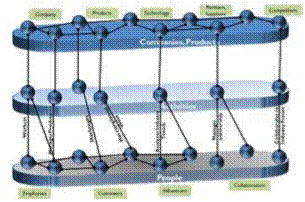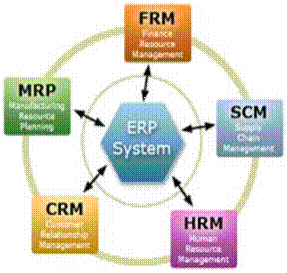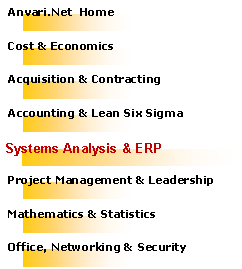
|
Enterprise Systems
Enterprise systems (ES) are large-scale application software packages that support business processes, information flows, reporting, and data analytics in complex organizations. While ES are generally packaged enterprise application software (PEAS) systems they can also be bespoke, custom developed systems created to support a specific organization's needs. Types of enterprise systems include: enterprise resource planning (ERP) systems, Enterprise planning systems, and Customer relationship management software.
Although data warehousing or business intelligence systems are enterprise-wide packaged application software often sold by ES vendors, since they do not directly support execution of business processes, they are often excluded from the term.
Enterprise systems are built on software platforms, such as SAP�s NetWeaver and Oracle's Fusion, and databases.� From a hardware perspective, enterprise systems are the servers, storage and associated software that large businesses use as the foundation for their IT infrastructure. These systems are designed to manage large volumes of critical data. These systems are typically designed to provide high levels of transaction performance and data security.
Army Enterprise Systems
General Fund Enterprise Business Systems (GFEBS) GFEBS develops, acquires, integrates, deploys and sustains enterprise-wide financial and procurement management capabilities to support Army�s current and future missions.� GFEBS is the Army�s new web-enabled financial, asset and accounting management system that standardizes, streamlines and shares critical data across the Active Army, the ARNG and the USAR. GFEBS uses Systems Applications and Products in Data Processing software, a COTS ERP solution.
Moving forward, GFEBS plans to negotiate roles and responsibilities with Financial Management and Comptroller by identifying subject matter experts on business process related issues, working with users to address problems, analyzing business processes, analyzing system or training problems, and proposing changes to� Support. GFEBS will also review cost estimates to right-size sustainment and will support the maturation of the Functional Governance Board process.
Logistics Modernization Program (LMP) LMP sustains, monitors, measures and improves the modernization national-level logistics support solution; transitions services from contractor to organic support without performance degradation; delivers new capabilities to achieve Business Systems Information Technology and DoD Enterprise Transition Plan objectives; addresses strategic Army/DoD business transformation elements; and supports DoD/Army ERP integration efforts and related end-to-end processes.
LMP supports the Army national-level logistics mission to develop, acquire, field and sustain the world�s best equipment and services, providing Soldiers with a decisive advantage. LMP delivers an enterprise system for AMC with a fully-integrated suite of software and business processes, providing streamlined data on maintenance, repair and overhaul; planning; finance; acquisition; and on weapon systems supplies, spare parts, services and materiel.
LMP Increment 1 is deployed to more than 50 locations with approximately 21,000 users throughout AMC and related major subordinate commands, depots, and arsenals, as well as the Defense Finance and Accounting Service.
Global Combat Support System � Army (GCSS-Army) GCSS-Army fields an Army automated information system as the primary tactical logistics enabler to support Army and joint transformation of sustainment using an ERP system; reengineers current business processes to achieve end-to-end logistics and provides unclassified feeder data to applicable command and control systems; and, implements tactical financial processes relating to supply and maintenance.
Integrated Personnel and Pay System � Army (IPPS-A) IPPS-A supports the Soldier in the core mission of conducting operations; promotes and maintains effective military personnel management; and ensures that accurate and timely military personnel data � including delivery of benefits � are available at all levels of management and oversight.
IPPS-A will provide the Army with an integrated, multi-component, personnel and pay system that streamlines Army HR, enhances the efficiency and accuracy of Army personnel and pay procedures and supports Soldiers and their families. The tool will be web-based, will be available 24 hours a day and will be accessible to Soldiers, HR professionals, combatant commanders, personnel and pay managers and other authorized users throughout the Army.� IPPS-A addresses major deficiencies in the delivery of military personnel and pay services and also provides internal controls and audit procedures that prevent erroneous payments and loss of funds.
Army Contract Writing System (ACWS) ACWS provides a single enterprise contract writing and management system to obtain business process efficiencies; supports compliance with the Federal Financial Management Act of 1996; integrates with existing ERP solutions; and decreases the number of complex interfaces while fostering audit readiness.
ACWS is projected to be an acquisition category IAM program that will replace Standard Procurement System (SPS)/Procurement Desktop-Defense and Procurement Automated Data and Document System. ACWS will comprise approximately 8,000 users at 280 sites in the CONUS and OCONUS.
ACWS will function in low bandwidth/disconnected status for expeditionary forces, and will support unclassified networks, classified networks and contracting requirements. is expected to utilize centralized services such as Clause Logic; standardized business rules including contract line item number structure and the like; and standard data schemas like Procurement Data Standard and Standard Financial Information Structure.
Army Enterprise Systems Integration Program (AESIP) The Army continues to modernize its ERP business systems to simplify operations, optimize processes, and provide an accurate, Enterprise view of business information to all users. AESIP is a key component of this initiative. AESIP integrates business processes and systems by serving as the Enterprise hub for the Army�s logistics and financial ERP business systems: General Fund Enterprise Business System (GFEBS), the Army�s financial system Global Combat Support System - Army (GCSS-Army), the tactical logistics system, Logistics Modernization Program (LMP), the national logistics system.
Description: AESIP enables integration by linking business processes and data across existing IT systems. This integration optimizes business processes and supports Enterprise level information requirements. AESIP has successfully delivered a Web-based solution for the creation and management of customer and vendor master data and implemented an optimized messaging and hub services capability.
AESIP houses and enables the Army Enterprise material master which provides the Army a single authoritative source for material data supporting all Army constituent (modernized and legacy) systems. This Army Enterprise material master provides the catalyst to manage, control, create, change, archive, and validate data, while providing a single global view of material thus, providing the basic building blocks for Product Lifecycle Management/Weapon System Management. Implementation of the Enterprise material master has enabled inventory management, accountability, pricing, accounting functions, and Material Requirements Planning (MRP) operations to be seamlessly integrated into the Army Enterprise vision.
Products and Services, AESIP services include:� Enterprise hub services, Enterprise master data management, Business intelligence and analytics. |


|
The course materials listed on this web site are copy rights � by the subject authors and publishers. They are solely intended for classroom teaching and online reference. Copy and/or redistribution of these contents are prohibited by the US copyright law. |







